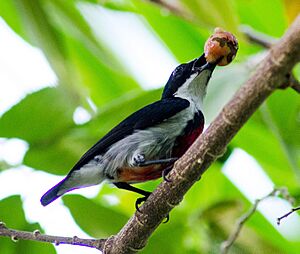Black-belted flowerpecker facts for kids
Quick facts for kids Black-belted flowerpecker |
|
|---|---|
 |
|
| Conservation status | |
| Scientific classification | |
| Genus: |
Dicaeum
|
| Species: |
haematostictum
|
The black-belted flowerpecker (Dicaeum haematostictum), also known as the Visayan flowerpecker, is a small, colorful bird. It belongs to a group of birds called flowerpeckers, which are known for eating fruits and nectar from flowers. This special bird lives only in the Philippines, specifically on the islands of Panay, Negros, and Guimaras. It used to be thought of as a type of red-keeled flowerpecker, but now scientists know it's its own unique species!
What Does the Black-belted Flowerpecker Look Like?
This bird is quite small. It has a black back that shines with a blue color. Its belly is white, but it has a bright red patch on its chest and belly. This red patch is outlined with black at the top, like a belt! The bird also has a fairly long and thin beak.
It can sometimes be confused with the Fire-breasted Flowerpecker. However, the black-belted flowerpecker has black feathers above its red patch, while the Fire-breasted Flowerpecker has black below it.
You can often hear this bird making high-pitched sounds or "chik!" notes, which are typical for flowerpeckers. It likes to eat from flowering and fruiting trees.
Where Does the Black-belted Flowerpecker Live?
The black-belted flowerpecker lives in tropical forests. It prefers forests that are moist and found in lowlands, up to about 1,000 meters (around 3,300 feet) above sea level. It likes both old, untouched forests (called primary forests) and forests that are regrowing (called secondary forests). Sometimes, it even visits farms and coconut plantations.
This bird is found only on the islands of Panay, Negros, and Guimaras in the Philippines. Sadly, it might already be gone from Guimaras.
Protecting the Black-belted Flowerpecker
Experts who study birds have said that the black-belted flowerpecker is a species of "least concern." This means they are not currently in immediate danger of disappearing. However, there are only about 6,000 to 15,000 adult birds left.
The biggest threat to this bird is habitat loss. This means their forest homes are being cut down. On Negros Island, almost all the original forests were gone by 1988. On Panay, only a small amount of forest was left. People cut down trees for farming, wood, and making charcoal. This continues to be a big problem for the remaining forest areas where these birds live.
Luckily, some areas where the black-belted flowerpecker lives are protected. These include the Northern Negros Natural Park, Mt. Canlaon National Park, and Balinsasayao Twin Lakes Natural Park.
To help these birds, scientists suggest a few things:
- They want to study the forests to find out how many birds are in different areas.
- They also want to figure out how much suitable forest is left to get a better idea of the bird's total population.
- It's important to protect the areas where these birds live, especially the Northern Negros Natural Park and other lowland forests in the Western Visayas region.


